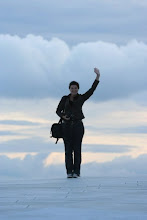

Kitaláltam, hogy csinálok egy sorozatot, amiben ötvözöm a két érdeklődési körömet: légköroptika és a középkor. Elég sok középkori halo-illusztráció létezik, és még több leírás. Ezekből jöjjön most egy, mégpedig az, ami miatt elkezdett a téma érdekelni. Pár éve Stockholmban láttam Jacob H. Elbfas (1600-1664) Vädersolstavlan című festményét, mely az 1535 április 21-i complex jelenséget ábrázolja. Első pillantásra talán kicsit irreálisnak tűnhet a kép, de valójában egyáltalán nem az, csupán el kell egy kicsit fordítani. Olyan, mint egy halszemoptikával készült fotó, melyen a város felett jól látszik a nap (a legfényesebb pont - bár nem egészen középen, mint ahogy kellene), egy 22°-os halo (mely, mint később kiderül, talán körülírt halo lehetett) és két oldalán a melléknapok, melyeken áthalad a parhélikus kör. A parhélikus körön távolabb feltűnik még három "nap". Ebből kettő a 120°-os melléknapok, közöttük a harmadik pedig az ellennap. A festmény egének közepén a félkör nem más, mint a zenit körüli ív. A jobb alsó részen a parhélikus körtől kifelé pedig egy infralaterális ív látszik.
Les Cowley nemrég készített nekem egy szimulációt, melyen a nap 38° magasan áll. Az eredmény magáért beszél; jól mutatja mi lehetett az égen azon a napon.
Idemásolom Les Cowley levelének pár részletét, mely elmagyarázza a szimulációt:
***
"At noon April 21, 1535 the sun was 45 degrees high (I think that the program has used the Julian calendar). Noon would put the sundogs too far from the 22 degree halo and too close to the circumscribed halo. I have attached a simulation for 38 degrees - a morning or afternoon rendition. Often these early drawings are a composite of features seen over several hours. Working outwards from the sun I think we have the 22 degree halo, two sundogs and then a circumscribed halo. This does not join the sundogs but if you look at its shape in the simulation you will see that it somewhat resembles the shape in the painting. Further away we have - as you say - an infralateral arc. The parhelic circle shows 120 degree parhelia and an anthelion where the Wegener arcs cross the parhelic circle. The composition of the Stockholm painting is beautiful and timeless. What do you think? It is possible to make other interpretations. "
***I've decided to start a series which brings my two fields of interest - atmospheric optics and the Middle Ages - together. There are quite a few medieval halo-illustrations and even more descriptions. Here is one of them - the one that made me interested in these phenomena. A few years ago in Stockholm I saw the Vädersolstavlan by Jacob H. Elbfas (1600-1664), which depicts the complex display of 21st April 1535. At first sight the picture might seem rather irreal, but actually it isn't. You only have to rotate it a little. It looks as if the picture was taken using a fish-eye lens. Above the town we can see the sun (the brightest spot - although not in the centre of the halo as it should appear), a 22° halo (as we'll see later there may have been a circumscribed halo) with the two parhelia. The parhelic circle runs across the 22° parhelia and further away we can notice three more "suns" on it. Two of these are the 120° parhelia and the one inbetween is the anthelion. The semicircle in the centre of the sky is the circumzenithal arc. In the bottom right hand corner, outside the parhelic circle there is an infralateral arc.
One month ago, Les Cowley made a simulation for me, which shows the sun 38° high, modelling what must have happened in 1535. The result speaks for itself.
Above in yellow letters you can see the relevant parts of Les Cowley's email, explaining the simulation.






No comments:
Post a Comment